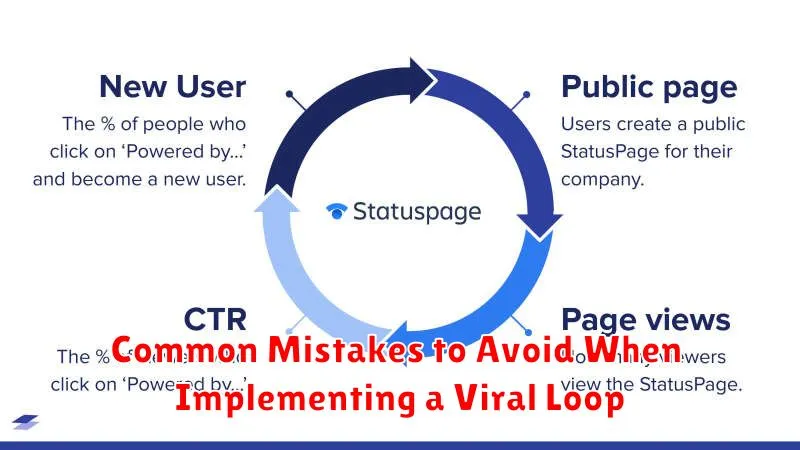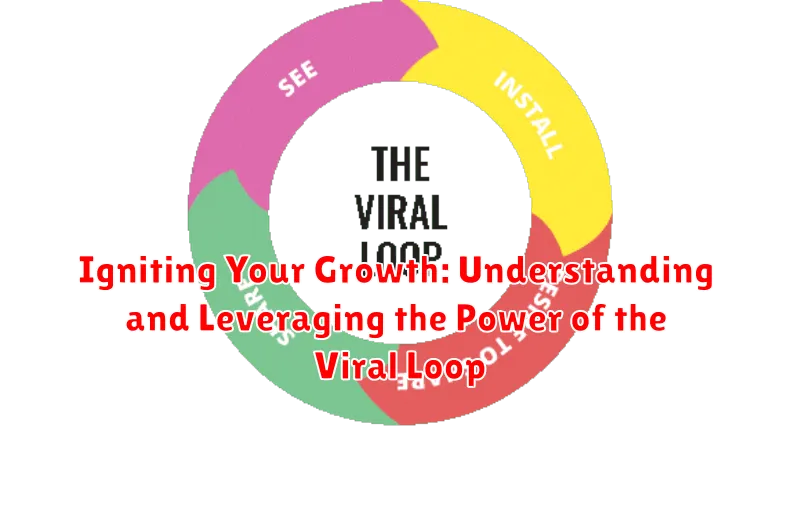In today’s interconnected world, achieving exponential growth is the ultimate goal for many businesses. One of the most potent strategies for achieving this is by understanding and leveraging the viral loop. A viral loop is a closed cycle where existing customers refer new customers, creating a self-perpetuating growth engine. This article explores the mechanics of the viral loop, providing insights into how businesses can ignite their growth by harnessing its power. We’ll examine key components, successful examples, and practical strategies for building and optimizing your own effective viral loops. By understanding how to create a system where your product or service effectively promotes itself, you can unlock unprecedented growth potential and establish a sustainable competitive advantage.
This comprehensive guide delves into the core principles of viral growth and the power of the viral loop. We will explore the different types of viral loops, analyze their effectiveness, and provide a clear roadmap for integrating them into your business strategy. You’ll learn how to identify the key metrics that drive viral growth, optimize your viral loop for maximum impact, and avoid common pitfalls. Understanding the viral loop is no longer optional; it is a crucial component of any successful growth strategy in the digital age. Embracing the principles outlined in this article will empower you to ignite your growth and propel your business to new heights through the power of the viral loop.
What is a Viral Loop?
A viral loop is a growth mechanism where existing users bring in new users, creating an exponential expansion. Think of it as a chain reaction, where each customer becomes a recruiter. This self-perpetuating cycle fuels rapid growth, increasing brand awareness and user base without relying solely on traditional marketing efforts.
Essentially, a viral loop leverages the power of word-of-mouth and network effects. It’s built on a compelling offer or user experience that motivates existing users to share it with their connections, who then become users themselves, perpetuating the cycle.
The core of a successful viral loop lies in its ability to incentivize sharing and simplify the invitation process. A clear and easy path for users to bring in others is essential for achieving virality.
The Mechanics of a Viral Loop
A viral loop operates on a cyclical principle, driving continuous growth through user-generated invitations and subsequent conversions. The core mechanic involves an existing user taking an action that exposes the product or service to new users. This action could be sharing content, inviting friends, or providing referrals.
This exposure triggers the next stage, where the new users are introduced to the offering. A compelling value proposition is essential at this point to encourage these potential users to convert into active users themselves. Conversion could involve signing up, making a purchase, or engaging with the core features of the product or service.
Once converted, these new users become potential initiators of the loop, perpetuating the cycle. The key to a successful viral loop is optimizing each stage to maximize the probability of each user inviting multiple new users, leading to exponential growth.
Types of Viral Loops
Several distinct viral loop types exist, each leveraging a different mechanism for growth. Understanding these differences is crucial for choosing the right loop for your specific business model.
One common type is the network effect loop. This loop relies on the inherent value increase of a product or service as more users join. Think social networks – the more friends on the platform, the more valuable it becomes to each individual user.
Another type is the referral loop, where existing users are incentivized to invite new users. Dropbox, for example, offers additional storage space to both the referrer and the referee upon successful signup.
Content loops leverage user-generated content to attract new users organically. Platforms like YouTube and TikTok rely on the continuous creation and sharing of engaging content to fuel their growth.
Finally, giveaway or contest loops often utilize limited-time promotions or contests to incentivize sharing and rapid user acquisition.
Benefits of Implementing a Viral Loop
Implementing a well-designed viral loop can offer significant advantages for businesses. A primary benefit is accelerated growth. By encouraging existing users to bring in new ones, businesses can achieve exponential growth rates compared to traditional marketing methods. This organic acquisition also tends to be more cost-effective, reducing reliance on expensive advertising campaigns.
Beyond rapid growth, viral loops foster increased brand awareness and visibility. As users share and promote the product or service within their networks, the brand’s reach expands organically. This word-of-mouth marketing builds trust and credibility, as recommendations from friends and family often hold more weight than traditional advertising.
Furthermore, viral loops can contribute to improved customer engagement and retention. The inherent social element of these loops creates a sense of community and encourages ongoing interaction with the product or service. This, in turn, can lead to higher customer lifetime value.
Examples of Successful Viral Loops
Examining successful viral loops provides valuable insights for designing your own. Dropbox, for instance, incentivized existing users to invite friends by offering additional storage space for both parties upon successful signup. This created a powerful incentive for sharing and accelerated user acquisition.
Airbnb leveraged a double-sided viral loop, engaging both hosts and guests. Guests were encouraged to invite friends to join the platform, often with a discount code, while hosts benefited from increased bookings through the expanded user base. This dual approach fueled rapid growth on both sides of the marketplace.
Hotmail, a pioneer in viral marketing, included a simple “Get Your Free Email at Hotmail” signature in every outgoing email. This subtle yet effective strategy exposed the service to a vast audience with minimal effort, driving rapid adoption in the early days of email.
Key Metrics for Measuring Viral Loop Success
Measuring the effectiveness of your viral loop is crucial for understanding its impact and making necessary adjustments. Key metrics provide valuable insights into the health and performance of your viral loop. These metrics allow you to identify areas for improvement and optimize your strategy for maximum growth.
The Viral Coefficient (K-factor) is a fundamental metric. It represents the average number of new users each existing user brings in. A K-factor greater than 1 signifies exponential growth. Tracking this metric helps determine the virality of your loop.
Cycle Time measures the time it takes for one loop iteration to complete. A shorter cycle time generally leads to faster growth. Understanding this allows for optimizations to streamline the process.
Retention Rate is essential for sustained viral growth. It indicates the percentage of users who continue engaging with your product or service after a specific period. High retention rates combined with a strong viral coefficient are crucial for long-term success.
By monitoring these key metrics, you can gain a clearer understanding of your viral loop’s performance and identify areas for improvement. Regularly analyzing these metrics is essential for optimizing your strategy and achieving sustainable viral growth.
How to Design an Effective Viral Loop for Your Business

Designing a successful viral loop requires careful planning and execution. Start by clearly identifying your target audience and understanding their online behavior. What platforms do they frequent? What motivates them to share content or invite others?
Next, pinpoint your core value proposition. What unique benefit does your product or service offer that users will be eager to spread to their network? This value proposition should be easily communicated and understood within the viral loop itself.
The incentive for sharing is crucial. Consider offering rewards for both the referrer and the referred user. These incentives can be discounts, premium features, exclusive content, or even simple recognition. Ensure the reward is valuable enough to encourage participation.
Seamless integration is key. The process of inviting and onboarding new users should be as frictionless as possible. Minimize steps, reduce required information, and optimize the user experience for mobile devices.
Finally, test and iterate. Continuously monitor key metrics and gather user feedback to identify areas for improvement. Experiment with different incentives and messaging to optimize your viral loop’s performance.
Common Mistakes to Avoid When Implementing a Viral Loop

Implementing a viral loop requires careful planning and execution. Overlooking key aspects can hinder its effectiveness and even damage your brand. Here are some common pitfalls to avoid:
Forcing the Referral: Don’t make sharing feel mandatory. Users are more likely to share when they genuinely believe in your product or service. Incentivize sharing, but don’t make it a requirement for core functionality.
Ignoring User Experience: A clunky or complicated user experience can quickly derail a viral loop. Ensure the sharing process is seamless and intuitive. Friction at any point can discourage participation.
Overpromising Incentives: Offering unrealistic rewards can attract the wrong type of users and lead to disappointment. Focus on providing value that aligns with both your brand and user needs.
Neglecting Measurement: Track key metrics to understand what’s working and what’s not. Without data, you’re flying blind. Analyze your viral loop’s performance and iterate based on the insights you gather.
Lack of Promotion: Even the best-designed viral loop needs a little push. Promote your referral program through various channels to increase awareness and encourage initial participation.
Tools and Resources for Viral Loop Analysis
Analyzing the performance of your viral loop is crucial for ongoing optimization and growth. Several tools and resources can assist in this process. Analytics platforms are essential for tracking key metrics. Choosing the right platform depends on your specific needs and the complexity of your viral loop.
Cohort analysis is a powerful technique for understanding user behavior over time. By grouping users based on when they joined, you can identify patterns and trends related to the viral loop’s effectiveness. This information can be used to refine your strategy and improve conversion rates.
A/B testing allows you to experiment with different variations of your viral loop. By testing different messaging, incentives, or referral mechanisms, you can identify what resonates best with your target audience. This iterative approach is key for maximizing the impact of your viral loop.
Additionally, various spreadsheet software and data visualization tools can be invaluable for organizing and visualizing data related to your viral loop’s performance. These tools can help you identify areas for improvement and track progress over time.

